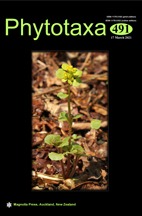Abstract
In this work we describe Stagonosporopsis rhizophilae sp. nov. (Didymellaceae, Pleosporales, Ascomycota), a new species isolated from the rhizospheric soil of Populus deltoides Marsh. Phylogenetic analyses based on combined multilocus sequences of internal transcribed spacers (ITS: ITS1, 5.8S, ITS2), and partial sequences of the large subunit 28S nrDNA region (LSU), β-tubulin (TUB), and RNA Polymerase II second-largest subunit (RPB2) clearly place this species within the genus Stagonosporopsis but distinguishes it from all known and closely related species such as S. nemophilae. Stagonosporopsis rhizophilae sp. nov. can also be differentiated from S. nemophilae by morphological characters and by the negative response of the NaOH spot test for the production of metabolite E.

